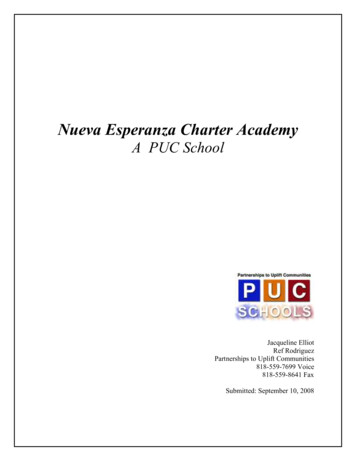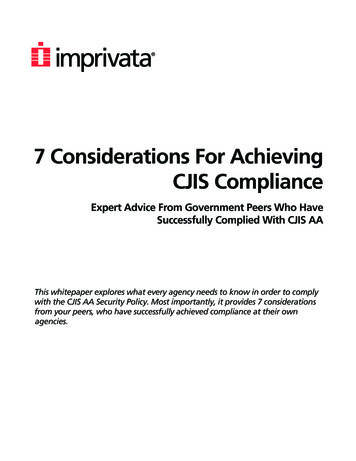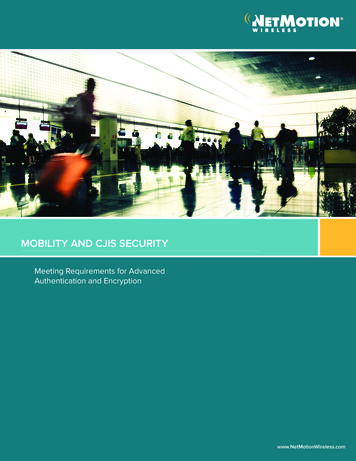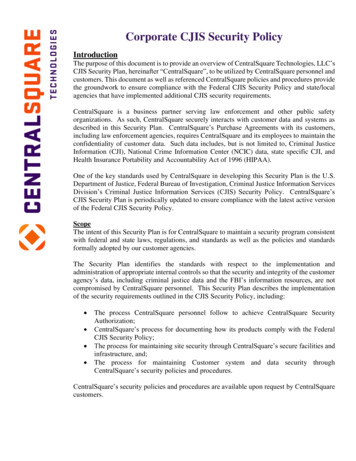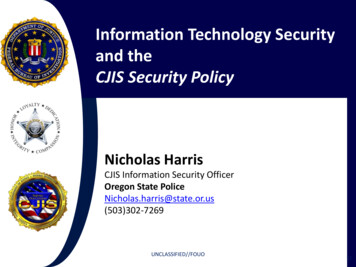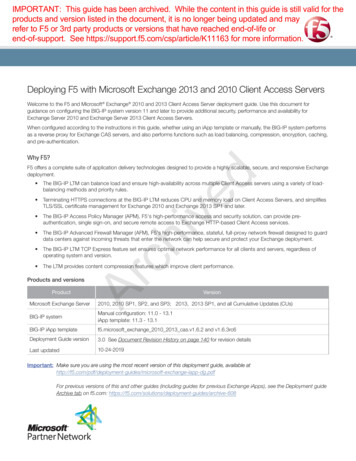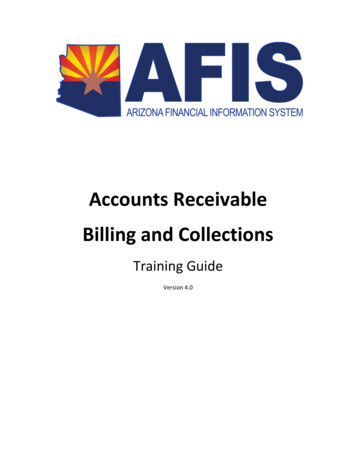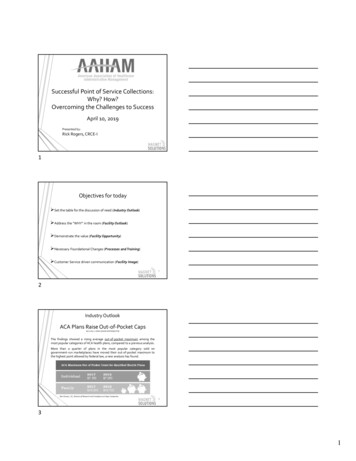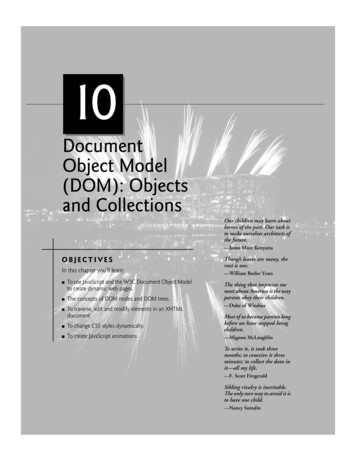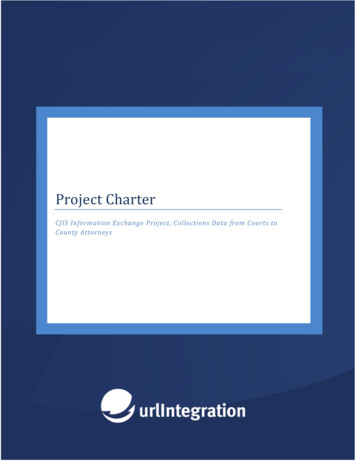
Transcription
Project Charter-Court Case Dispositions ExchangeProject CharterCJIS Information Exchange Project, Collections Data from Courts toCounty Attorneysi
Project Charter-Court Case Dispositions ExchangeTABLE OF CONTENTSTABLE OF CONTENTS. iiDOCUMENT HISTORY . ii1.0PROJECT OVERVIEW . 12.0PROJECT GOALS AND OBJECTIVES . 13.0STAKEHOLDERS . 24.0BENEFITS AND DELIVERABLES . 25.0RISKS . 36.0ROLES AND RESPONSIBILITIES . 46.1RESOURCE ALLOCATION . 57.0COMMUNICATION . 68.0APPENDIX . 79.0APPROVALS . 8DOCUMENT 21/2012Author(s)J PingelE GreenR CollinsRevision NotesInitial DraftInternal ReviewFinal QA Reviewii
Project Charter-Court Case Dispositions Exchange1.0PROJECT OVERVIEWCounty Attorneys in Iowa are authorized to begin a collections process once fines, fees or othercourt costs on a case become 90 days past due. Many County Attorneys across Iowa have acollection program in place, and most of them utilize their case management system (CMS). Theyrely on timely and complete information from the Iowa Courts’ Information System (ICIS) to stayupdated on which cases are eligible for collections, and the amounts collectable.This exchange will send the collections and payments data from the ICIS court case management toa County Attorney’s CMS. For the initial installation of this exchange, CJIS will partner with theIowa Counties’ Association, and the Iowa County Attorneys’ Case Management Project. Theendpoint for the first implementation of this exchange will be the ProLaw case managementsystem. The exchange will monitor cases that are currently being collected by the County Attorney(CA) and new cases that will be assigned to the CA in the future. The case ID for every case in CAcollections will reside in a listener table on the ICIS database. These case IDs will remain on thelistener table until the collections on the case is complete.Data-integration projects like this involve managers, line staff and information technology (IT) stafffrom multiple agencies. Several private-sector vendors are also typically involved. As a result,coordination at the outset of the project is essential. This document initiates that coordination. Thepurposes for this charter include: 2.0To level-set all project participants in terms of the basic objectives of the project;To begin the analysis of project feasibility;To identify general resource needs, and to establish target dates or time frames for devotingthe needed resources to the project;To understand and discuss the interdependencies between the partner agencies and theirvendors.PROJECT GOALS AND OBJECTIVESIn 2012 URL Integration worked with Polk County’s IT and Sheriff Departments to create anexchange that provided both Disposition and Payment information for Polk County court cases.Polk County staff wrote the data to a local database, which they use to manage dispositions andpayments internally.In the course of that project, URL created the components at the courts’ ICIS system and the CJISProgram’s Enterprise Service Bus (ESB) that can be adapted to provide collections/payment data toany interested recipient. The services and data-integration required for a recipient –whether acounty attorney or a state agency—will be part of the scope of this project.1
Project Charter-Court Case Dispositions ExchangeA “Dispositions to County Attorneys” project was initiated by CJIS’ prime contractor, URLIntegration, in July 2012. This charter initiates the second “half” of this effort, providing collectionsdata to other county attorneys.Thus, the overall goal of the project is to build and deploy into production (for at least one recipientendpoint) a CJIS exchange that provides collections information.The objectives necessary to meet that goal include:1. Document the business requirements for maintaining collections data in a county attorney CMS.2. Modify the Polk County Dispositions and Payments exchange that was developed in 2012 toaccommodate a wider audience of recipient agencies/systems.3. Re-use the web services and processing components built for the Polk County project to publishcollections updates.4. Create ICIS database triggers to publish collections and payment information from any Iowacounty.5. Develop ESB code for the Collections exchange.6. Develop receiving web services to be used by county attorneys.7. Develop the required data integration and processing components for county attorneys toconsume collections data and process it as required.3.01.2.3.4.4.0STAKEHOLDERSIowa Judicial Branch – Office of the CIOIowa County AttorneysIowa County Attorneys Case Management Project (ICACMP)Iowa CJIS (Criminal Justice Information Systems) ProgramBENEFITS AND DELIVERABLES1. The benefits of automated, near-real-time collections reporting include:2. Improved timeliness in data exchange.a. Better collections rates, resulting in potential revenue increases for counties.b. Reduced cost in re-programming the interface when databases and applicationschange on either side.3. Major Milestonesa. Full documentation to include:i. Business requirementsii. NIEM-conformant IEPD (xml schemas, examples and documentationiii. A Solution Architecture, conformant with the US Department of Justice’sGlobal Reference Architecture, which fully documents the secure webservices communications between the systems.2
Project Charter-Court Case Dispositions Exchangeb. Components at the Courts:i. Event/listener table and triggers.ii. Java programming to bind records to xml.iii. Web services client.c. ProLaw Components:i. Web service client to receive xml messages from ESB.ii. Data integration to parse the xml and populate the Collections Tab in theapplication with updated data.d. ESB components:i. Send and receive web services and clients.ii. Security and encryption.5.0RISKS1. Initially identified risks include:a. Availability of programming staff – aligning multiple team members’ timelinesversus other competing priorities.b. Unforeseen complexity in modifying Collections schemas or web services.c. Whether the data elements extracted from the courts’ CA Daily and CA Weeklytables for the Polk County project are sufficient for processing by the receivingpartners.d. The magnitude of programming changes required for endpoint systems to receiveand match it to existing tables in fields.e. The timing of CJIS’ migration from the existing ESB environment to an upgradedOracle Service Bus (OSB) environment.2. Risk Management Strategiesa. At the outset, stakeholders and project managers from all agencies will reviewtimelines and competing priorities, and identify the best timeline during Fiscal Year2013 to begin and complete the required tasks, with minimal interruption.b. The project team will review the courts’ data-entry practices in a county beforeselecting that county for implementation of this exchange.c. Scope will be managed by limiting the data to be exchanged to the data currentlyextracted for Polk County, from the CA Daily, CA Weekly and related tables.d. The URL Project Manager will maintain a project plan in Microsoft Project whichwill detail the dependencies among agencies. The plan will be adjusted toaccommodate risks, unforeseen additional tasks, and delays.3. Unidentified Risk Managementa. Project managers from URL and the partner agencies and vendors will communicatewith each other regularly, and clearly identify risks as soon as possible.b. Once the project is initiated, the project team will hold regular conference calls forproject status updates. The team may agree on weekly or biweekly intervals for the3
Project Charter-Court Case Dispositions Exchangecalls. The goal of each call will be a brief status update on all active tasks, a reviewof upcoming tasks and dependencies, and identification of project risks. In-depthwork between two or more team members will be scheduled during the statusmeeting; however the main objective of the regular calls is issue identification.Resolution will be scheduled to be dealt with offline, in between meetings.4. Project Dependenciesa. Team member availability:i. Competing priorities for Courts-ICIS’ development staffii. Competing priorities for CA development staffiii. Competing priorities for URL staffb. Implementation of the State’s new OSB environment.5. Risk Mitigation Strategiesa. Project planning at the outset, to identify dependencies among team members, aswell as windows of opportunity for specific development tasks around other,external priorities.b. If the new OSB environment is not ready, the project team (primarily URL and CJIS)will have to decide whether to deploy to the existing ESB environment, or postponedeployment and testing milestones until the OSB environment is available.6.0ROLES AND RESPONSIBILITIESNameOrganizationRoleKeith KreimanCJISCJIS Executive SponsorMark HeadleeCourtsExecutive SponsorTim GilchristCourtsProject ManagerCourtsTeresa SmithStory County Attorney’sOfficePilot implementationsite managerZetta PilchIowa County Attorneys’Case Management ProjectExecutive SponsorCounty AttorneysJared PedersenURL PMOProject SponsorContact4
Project Charter-Court Case Dispositions ExchangeRichard LouURLTechnical LeadJim PingelURLProject Manager6.1RESOURCE mated)Dave Schmitz/KenAndersonCJIS/URLESB DeveloperESB Services20 hoursTim GilchristCourtsTestingProject ManagerCourtsResourcescheduling10 hoursCourt SMETestingTeresa SmithCountyAttorneyrepresentativeSubject MatterExpert(s) – attorneys’use of disposition dataDatarequirements –countyattorneys10 hoursElena gration forCA systemsTBDRoxanneShermannURLTechnical Lead,Developer of webservices for CAendpoints60 hoursRobert WinchellURLDeveloper of Courts’services and40 hours5
Project Charter-Court Case Dispositions ExchangecomponentsCheryle StuhmerURLBusiness AnalystExchangerequirements20 hoursDocumentationTestingJim Pingel7.0URLProject Manager40 hoursCOMMUNICATIONCommunication MethodDistribution ListTiming of CommunicationStatus conference callsCore project teamWeekly or biweeklyDashboard –milestones %complete, known project risksCore team and executivesponsorsMonthlyRisk mitigationCore project team, escalated toexecutive sponsors if necessaryAs needed6
Project Charter-Court Case Dispositions Exchange8.0APPENDIX Polk County Disposition and Payments IEPD (Spring, 2012)Dispositions to County Attorneys IEPD, December 2012.7
Project Charter-Court Case Dispositions Exchange9.0APPROVALSThe undersigned agree to the project parameters described above, and commit to moving forwardto assessing the feasibility and timeline for this project:NameRoleMark HeadleeCourts ExecutiveSponsorZetta PilchICAMCP RepresentativeKeith KreimanCJIS Executive SponsorJared PedersenURL PMOSignatureDate8
Project Charter-Court Case Dispositions Exchange 2 A “Dispositions to County Attorneys” project was initiated by CJIS’ prime contractor, URL Integration, in July 2012. This charter initiates the second “half” of this effo
